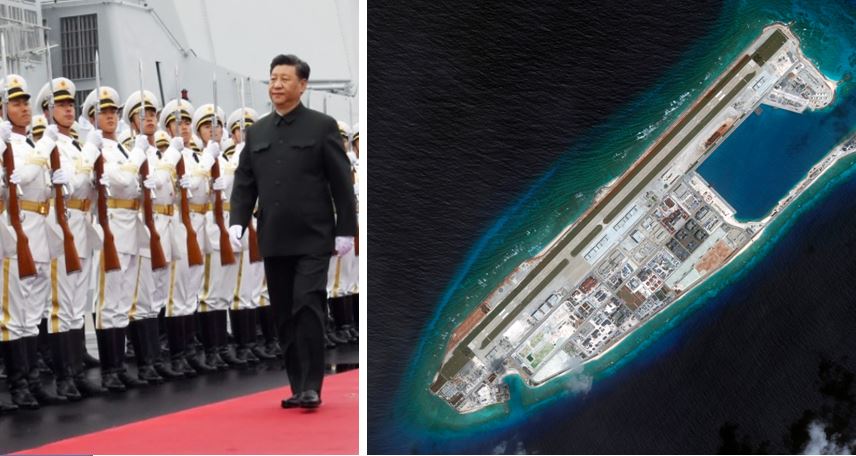One of the most immediate and natural consequences of the Coronavirus Pandemic has been the declaration of Beijing being a pariah by countries across the world, and the mighty Dragon, which isn’t a very responsible military and economic giant anyway has turned even more hostile in the South China Sea, a maritime region that has been a centre of multilateral disputes and tensions for decades.
In fact, taking advantage of the Coronavirus Pandemic and the debilitated US military that had to dock two of its aircraft carriers in the Pacific, Beijing has been trying to push its illegitimate interests in the strategic waterways for quite some time now.
Over the past few weeks, there has been a sharp rise in Beijing’s aggressive expansionism against other stakeholders in the maritime region- Vietnam, Taiwan, Philippines and Malaysia in the South China Sea, and Japan in the East China Sea.
China has been threatening Taiwan with clear attempts to corner the island with its naval assets even in the backdrop of the Coronavirus outbreak.
Recently, a strike group, consisting of two 052D guided-missile destroyers – the Xining and Guiyang – two 054A guided-missile frigates – the Zaozhuang and Rizhao – and supply ship, the Hulunhu accompanying China’s first operational aircraft carrier, Liaoning sailed in waters East of Taiwan and further towards the Southern direction of the island, carrying out exercises.
Beijing has also been more forceful with its “historical maritime rights” and the “nine-dash line” doctrine, which the country claims is not affected by an International Court of Justice (ICJ) ruling regarding territorial disputes in the South China Sea.
Admittedly, China’s claims on geographical features in the region are in gross violation of international maritime law. Yet Beijing has gone ahead renaming 80 geographical features in the South China Sea- standard names for 25 islands and reefs, and 55 geographic locations in a move that reeks of China’s clear attempts to establish its territorial sovereignty upon the disputed geographic sites.
China’s confrontations with Malaysia and Vietnam too are on the rise, which has led to the US Navy also getting involved in Beijing’s sudden powerplay in the maritime region.
Haiyang Dizhi 8, a Chinese research ship was found conducting a survey close to an exploration vessel operated by Malaysia’s state oil company Petronas, recently.
Following China’s confrontation with Malaysia, two American naval warships-
USS America and USS Bunker Hill had also entered the fray days ago.
Moreover, over recently a Chinese survey ship, Hai Yang Do Zhi 8, came as close as merely 92 nautical miles off the coast of Vietnam’s Binh Dinh province, intruding purposively into Hanoi’s Exclusive Economic Zone (EEZ).
In the East China Sea, Chinese naval warships recently sailed through the Miyako Strait that lies between Japanese islands of Miyako and Okinawa. Last week, Japanese Foreign Minister Toshimitsu Motegi lodged a protest against China for sending its naval assets into Japanese waters near the Senkaku Islands.
But these developments should be particularly disconcerting for New Delhi for two major reasons.
Firstly, the recent developments of China ramming a Vietnamese ship days after Hanoi protested against China’s actions in the South China Sea and Chinese jets approaching the tiny island of Taiwan, show that Beijing is trying to collide with other stakeholders in maritime regions where it claims to possess “historical maritime rights”.
Secondly, as Chinese hegemony gets challenged due to the outrage that it is facing over Coronavirus cover-up across the world, Beijing might want to regain its influence through forceful action, and Chinese actions are heavily concentrated on South China’s Western end that is located in close vicinity of the Indian Ocean Region (IOR).
China is currently targeting countries like Vietnam and Indonesia that share close economic and military ties with India. These are strategic waterways we are talking about, which is why China also takes a deep interest in the South China Sea. Now, if Beijing prevails in the disputed areas of the Sea, India’s trade routes with these countries could be impaired.
Abhijit Singh of the Observer Research Foundation (ORF) says that China’s growing influence in the South China Sea region could lead to Beijing expanding its influence in the Indian Ocean Region (IOR).
Abhijit Singh observed, “China’s expanding presence in littoral coincides with a rise in Chinese activity in the eastern Indian Ocean, particularly the presence of Chinese research and survey vessels in India’s EEZs.”
Now, if Beijing is successful in bullying around with other stakeholders in the South China Sea solely out of the military firepower mismatch between Beijing and other players in the maritime region, it would try to use island outposts to exert greater naval influence in the Indian Ocean.
If China is successful in forcefully asserting its illegitimate claims in the South China Sea- it could follow the same tactics in the Indian Ocean Region, taking over geographical features in the maritime region and setting up artificial islands to challenge India’s legitimate sphere of influence in the strategic Indian Ocean.
